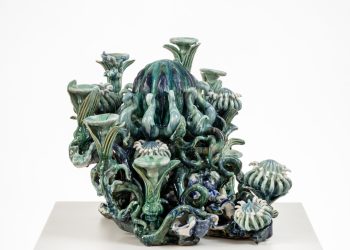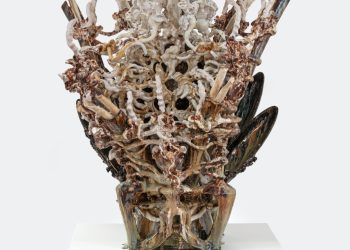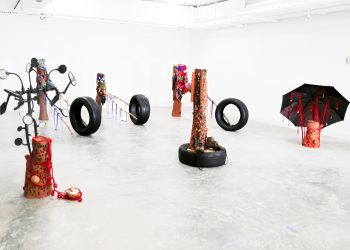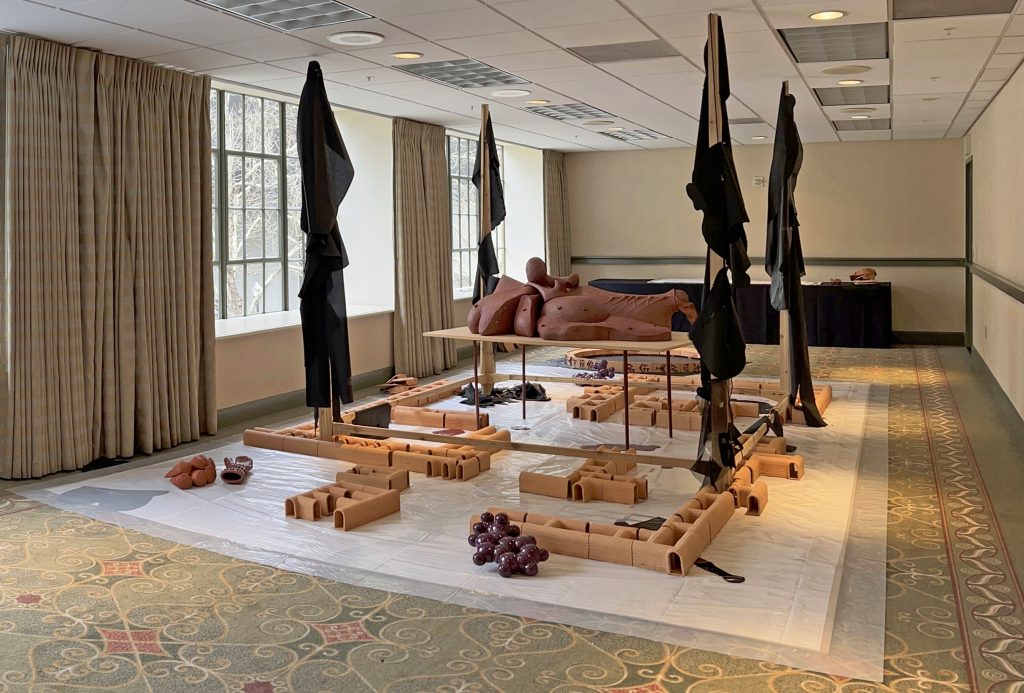
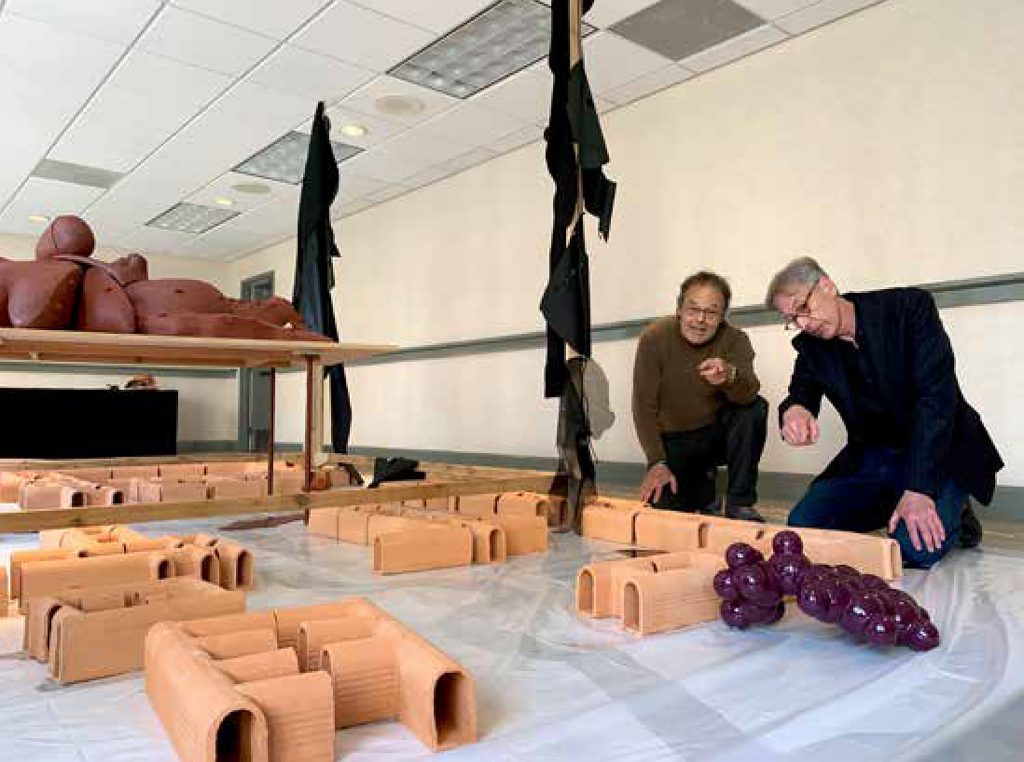
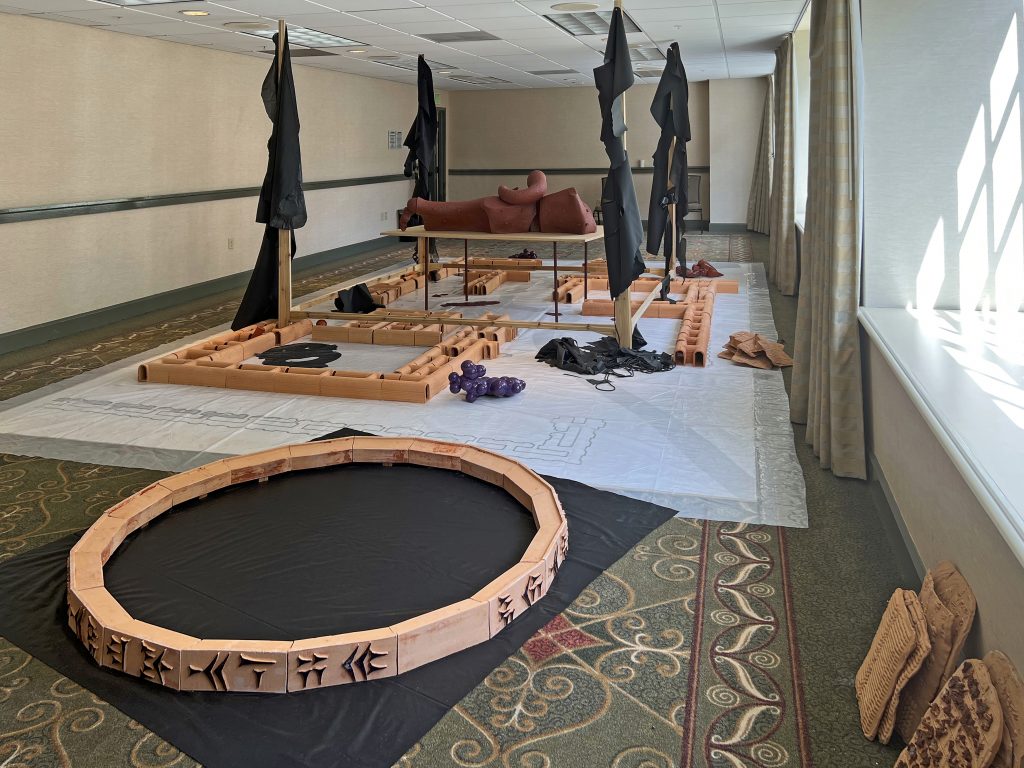
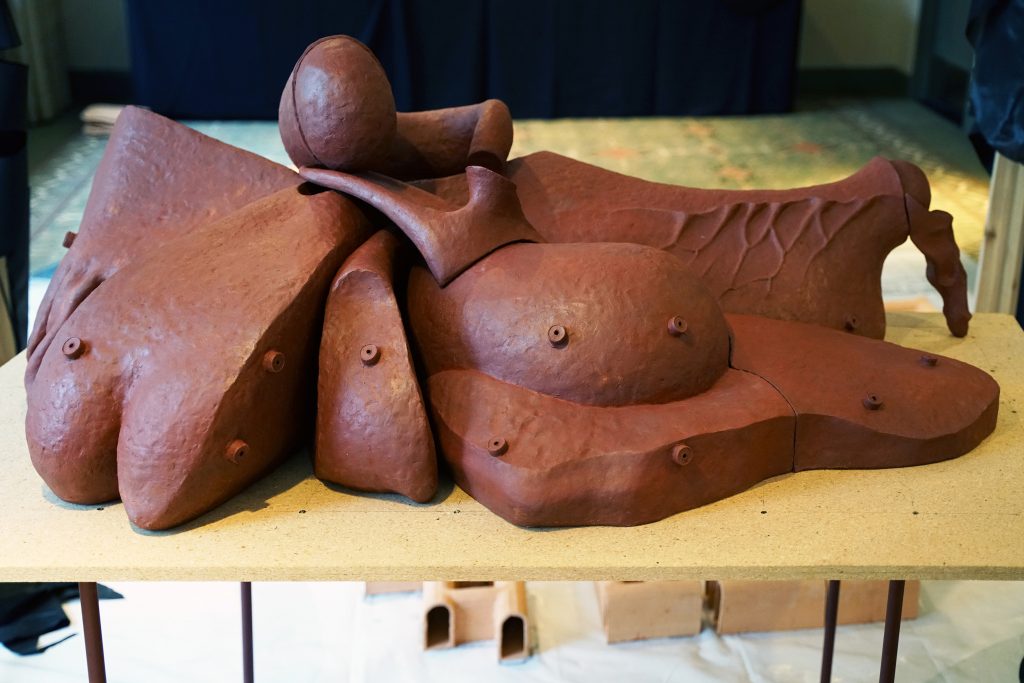
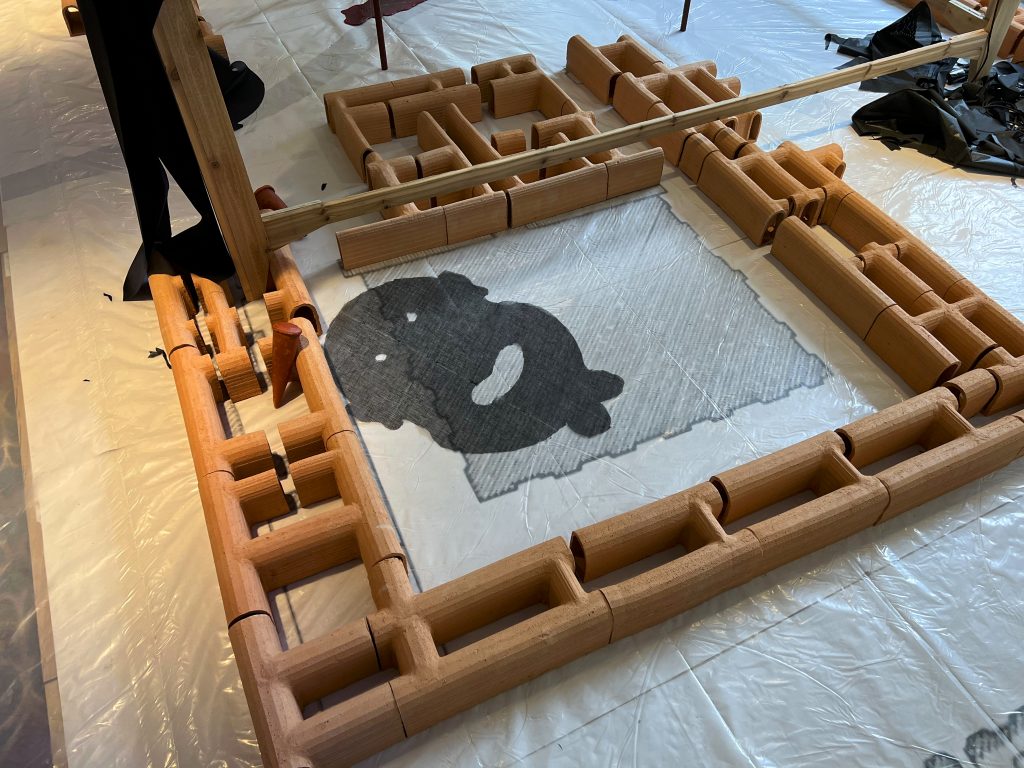
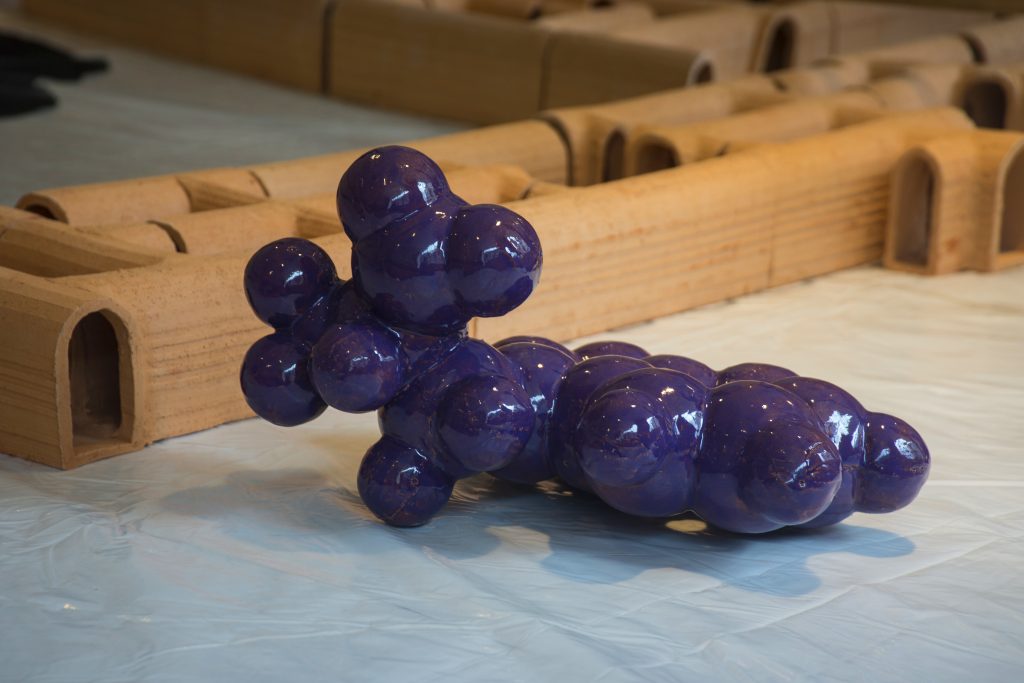
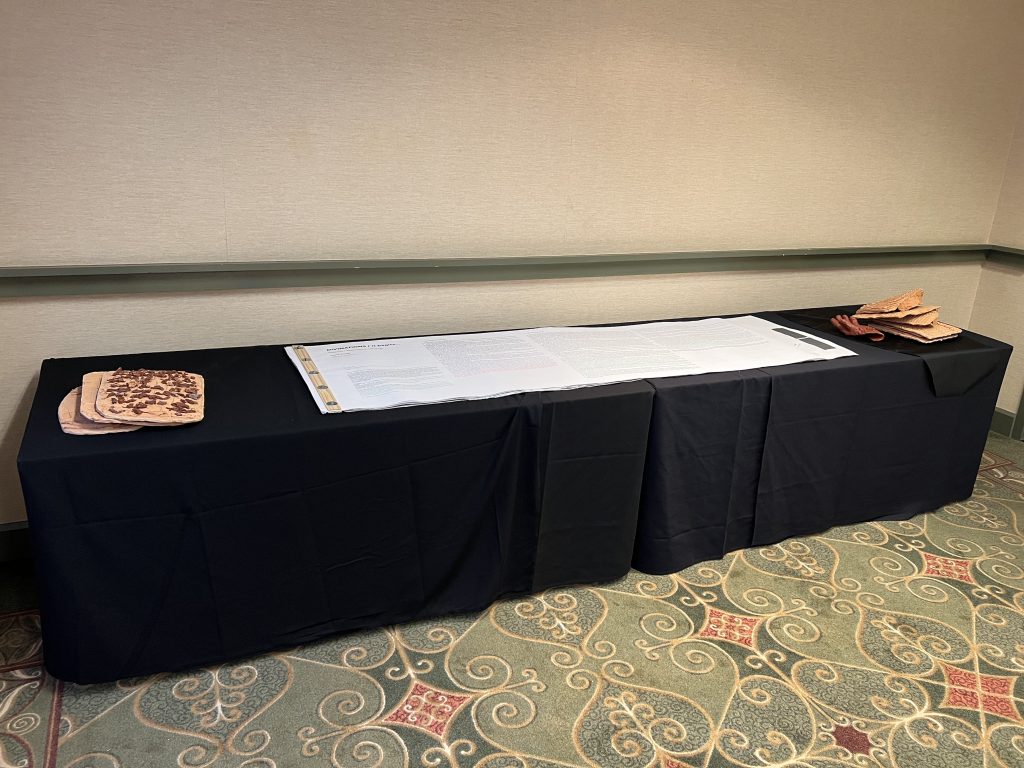
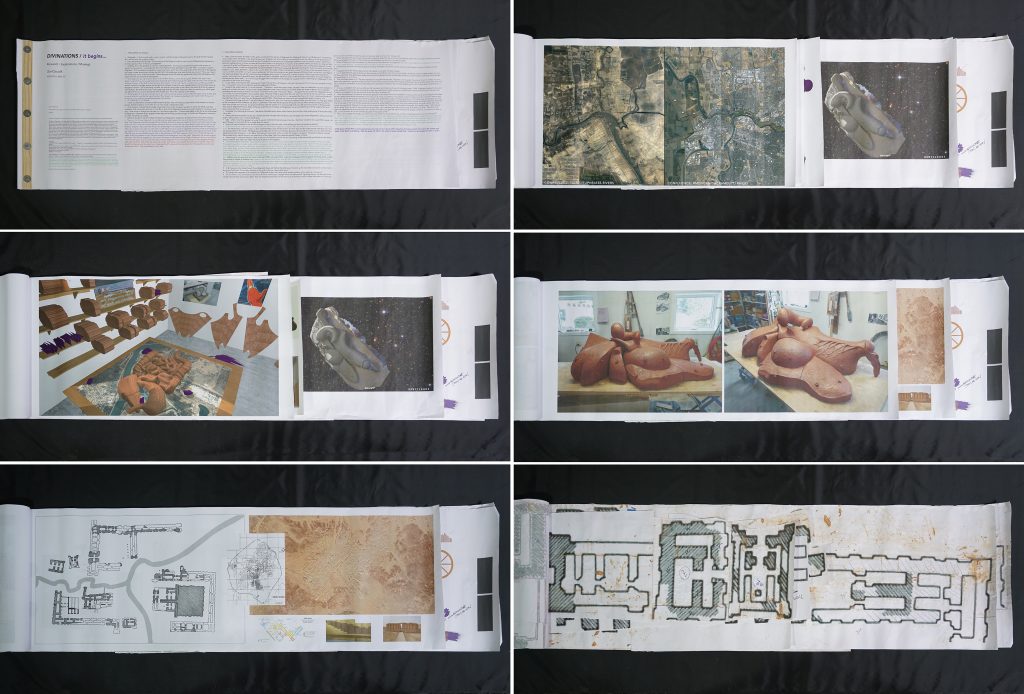
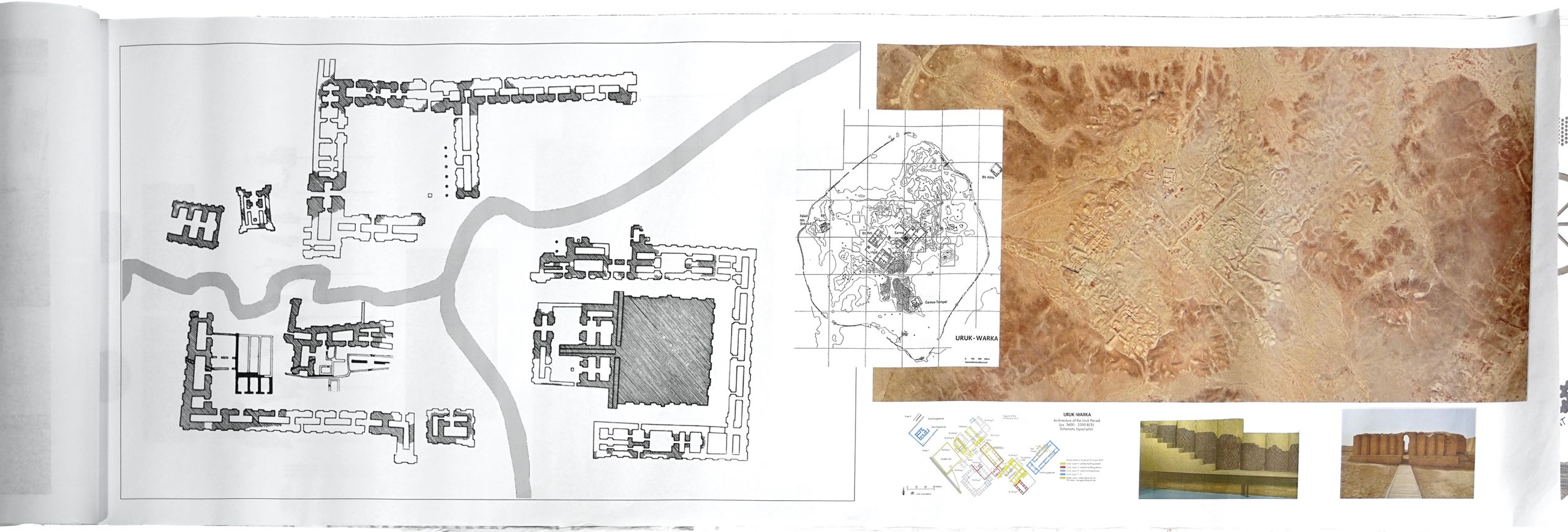
Neil Forrest & John Roloff: Divinations, 2022
OortCloudX’s research for Divinations began with cuneiform writing – impressed script into clay tablets. Clay as the first medium onto which ideas, warnings, and prosaic information was recorded. Examining clay tablets led us to the earliest libraries…and in Divinations we connect the earliest written forms to these early repositories, with our own inscribed clay tablets sitting adjacent to an extruded clay floorplan of one of first libraries. We see an elegant material loop in knowing the libraries themselves, were molded from clay.
Invited to exhibit in Sacramento for the 2022 NCECA conference, Divinations is also a contemporary response to the coincidence of fertile Uruk in Mesopotamia to agrarian Sacramento, both cities established at the confluence of vital rivers systems. The paper print of the Tigris and Euphrates on the gallery floor becomes our nod to the Sacramento and American Rivers – our fertile ground. Divinations used an improvised gallery space as operation headquarters and personal library, where we presented an animated floorplan and map that superimposes ancient sites to current ones, making associations and provocations between the Paleolithic, Neolithic and mid-Anthropocene.
Our library plan is a network of tunnels that prefigure a journey through the unconscious, as though beneath a temple-library, perhaps in the original Sumerian city, or in the anxious mind of King Gilgamesh. The project engages the immersive nature of clay, the medium with which recorded history begins. Clay not as pottery, but as books and cities in numinous physical presence. Considering cuneiform tablets, the most compelling archaeology gives us the first sweeping narrative poem: ‘The Epic Gilgamesh’. It chronicles the King’s confrontational and mystic journey, which we can now envision as a cautionary tale about unrestraint and environmental exploitation.
Centered in our gallery ‘library’ is a cube-shaped cedar structure which frames a sculpture of animal entrails. In divination practices of Mesopotamia, animal viscera and its pathologies were interpreted into prophesy. It could be said that divination and wonder were valid techniques of survival and probably power, and likely an empirical practice which connected the early science of medicine to the divine. If pinpointing the earliest documents that transcribe ideas, omens and divinations, cuneiform tablets spoke to the psychic roots of civilization as uncovered in The Epic Gilgamesh. The theme of this distant poem foreshadows several current global crises in uncanny ways like the destruction of the world’s forest ecosystems, while appreciating the wondrous and mysterious.
Our cedar structure faintly echoes the Kaaba, and from its corner posts hang black cloths, occasionally able to be read as the characters from the Gilgamesh story and limpid hints of Iraqi oil reserves. We retell the Mesopotamian epic in our own terms – where the ‘otherworld’ could be contemporary times, or into the future. The artists’ relationships to the Epic are further explored in a ragged and oversized book in which we summarize the poem, where we offer interpretations (we imagine Humbaba the monster as the primal representative of nature and the Paleolithic hunter-gatherer, but also the ecologist, the resource guardian of cedar forests), where we present our ideas for a future installment of Gilgamesh’s journey (next stop…Mars). We urge Gilgamesh into our present and our future, and now envisions a ‘purple rain of meteors laced with tryptophan’ (a sleep potion) which heralds an expansive portent for mankind.
Creating a contemporary and annotated version of Gilgamesh is to better explain the story to ourselves, and consequently, randomly fuel new details and methods of divination. Re-making the Epic as a new document, we add bits of our own process and the missteps that brought us to this particular arrangement of speculations. Our entrails pile sits overscale and majestic in our library of blueprints, cedar structure and Mesopotamian detritus. At the edge is a Catherine Wheel, typically representative of Christian cruelty, here to spin the melodrama of Prince’s most famed song.
OortCloudX sees a bond between mystic practices and contemporary scientific ones, understanding that artists sometimes act as pop culture shamans. From scholar Sarah Graff, we know “in Mesopotamian thought, clay was considered to be one of the basic ingredients of life…and clay was mixed with the flesh and blood of a sacrificed god and molded by the mother goddess to create gods and humans”.
As manipulators of a supernatural medium, we see the action of divination as a way to find justification for the unconscious decisions we make. As well, to ‘read the entrails’ is to hunt for the watermarks of knowledge transfer, and sometimes connect with a fearsome and largely archetypal past.
Neil Forrest & John Roloff / John Roloff & Neil Forrest
Divinations (an installation by OortCloudX > Neil Forrest/John Roloff)
Compagno Room, Sheraton Grand Hotel, Sacramento, CA / Fertile Ground, NCECA 2022
Terra cotta clay, terra sigillata, glaze, printed matter, cloth, cedar, steel, 36 ft. x 21 ft. x 8 ft. (10.97 m x 6.4 m x 2.44 m).
- Fig. 1
Installation view, front
Building on the associative power of ceramics, the inclusion of printed matter, shaped cloth, and cedar lumber broaden the material, historical and philosophical dialog of Divinations. The excavation plan of a temple and library at ancient Eanna, near the Tigris and Euphrates Rivers, spreads over the gallery floor. A network of extruded tunnels align with the ruins that prefigure a journey through the unconscious. - Fig. 2
John Roloff (left) and Neil Forrest (right) conversing about their installation Divinations.
Photo: Esther Rojas-Soto. - Fig. 3
Installation view, rear.
The installation portrays the pervasive use of clay as books and architecture, the medium from which recorded history begins. Clay tablets sit against the wall, much like the 3,600 year-old cuneiforms on which the Epic of Gilgamesh was inscribed. A cube-shaped cedar structure sits at the center to faintly echo the Kaaba from which black cloth silhouettes of characters from the Epic hang framing an over-scale sculpture of animal entrails. The entrails are the instrument of the ancient divination practices. “We retell the Mesopotamian epic in our own terms – where the ‘otherworld’ could be contemporary or the future.”
Photo Esther Rojas-Soto. - Fig. 4
Installation view, detail
Horse viscera/entrails, stoneware, terra sigillata, wood, steel, 68 in x 39 in x 42 in (with table). - Fig. 5
Installation view, detail
The geotextile silhouette of the head of Humbaba, guardian of the Cedar Forest, lies over a schematic ceremonial platform represented on the map of the Library of Eanna. - Fig. 6
Installation view, detail
A fallen tryptophan (amino acid of sleep) molecule/meteor of the ‘Purple Rain,’ a meteor shower dreamt by Gilgamesh in our revised sequence of his dreams. Glazed ceramic. - Fig. 7
Installation view
Divinations/it begins..,
Research / Explorations / Musings
OrtCloudX / 2022 BCE to 2022 CE
A 24 in. x 74 in. bound book, and associated objects, that includes a summary and revisions of the “Epic of Gilgamesh,” maps of ancient Uruk and contemporary Sacramento, studies of the gallery space and extrapolations, as well as other “bits of process and missteps that brought us to this particular arrangement of speculations”.
Photo Esther Rojas-Soto. - Fig. 8
Divinations/it begins.., sample pages.
Six pages from the book, 24 in x 74 in., paper, ink, wood metal, clay smears. - Fig. 9
Divinations/it begins.., sample page.
Plan view of the ruins of the Eanna Library at Uruk-Warka used in larger form as the floor and map for the layout of the installation’s extruded terra cotta tunnels and a satellite view and images of contemporary Uruk-Warka.



